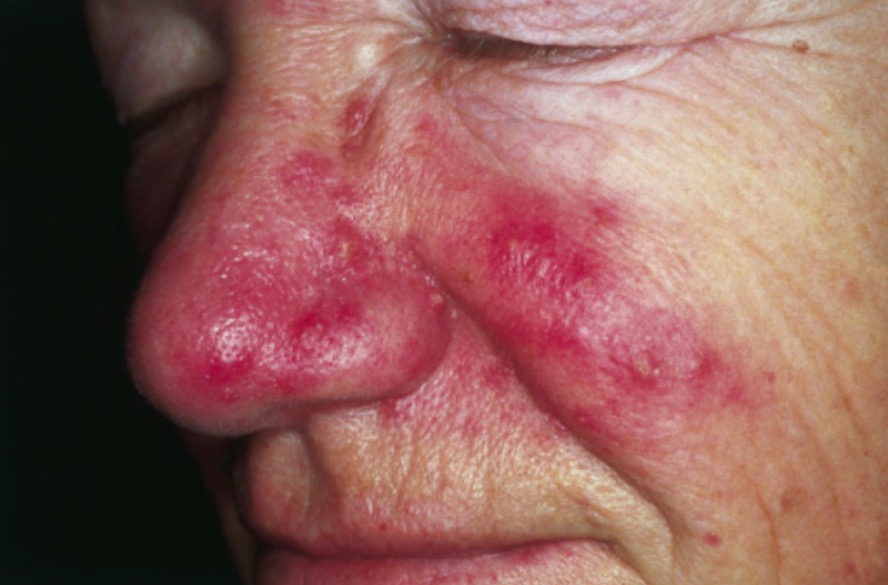Playlist
Show Playlist
Hide Playlist
Rosacea in Darker Skin: Presentation, Diagnosis, and Management
-
Slides Rosacea in Darker Skin.pdf
-
Download Lecture Overview
00:01 Welcome to our lecture on rosacea. 00:05 Rosacea means rose colored. 00:08 It's a chronic inflammation associated with capillary hyperactivity. 00:14 The rose colored skin may not be observed in darker skin tones because of the melanin that actually camouflages the erythema. Rosacea has a worldwide incidence of about more than 5%. The age of presentation ranges between the ages of 30 and 50. 00:37 Women tend to be more affected than men. 00:42 It's actually more common in individuals with light skin than in those with darker skin tones. 00:49 If one looks at the pathophysiology of rosacea, the actual etiology is still not completely understood, but there is a genetic predisposition as well as other factors such as infections due to the demodex mites as well as Helicobacter pylori. 01:11 The second contributing factor is ultraviolet radiation. 01:16 This vascular hyperactivity causing prolonged flushing, and this can be due to exercise, hot weather, spicy food, alcohol use, and stress. There are drugs that can be implicated in rosacea in what we call drug-induced rosacea, particularly topical and systemic steroids. 01:37 We see this quite commonly in some patients who may try to bleach their skin or try and treat acne with inappropriate use of topical steroids. 01:48 Infections can also cause or trigger rosacea, and we call this HIV-related rosacea. 01:55 And this has been described in our center in patients who have retroviral disease. 02:03 There are four major clinical manifestations of rosacea. 02:06 The first one being erythema totelangiectatic rosacea, papulopustular, the third one is ocular and phymateus rosacea. 02:15 So if we take a closer look at erythemato telangiectatic rosacea, as the word says, erythema and telangiectasia, this is what we see. 02:25 And as mentioned, it's more common in fair-skinned individuals. 02:29 You get erythema or redness, as well as telangiectasia that you can see on the skin, and the distribution is that of the butterfly rash on the nose and on the cheeks. 02:42 You tend to get also central facial flushing, which is transient in the beginning. 02:47 But if rosacea is not treated, it becomes permanent with time. 02:51 And it is impossible or difficult or rather challenging to treat. 02:57 You also see telangiectasia, which is a fine, dilated vessels. 03:02 In dark skin it is almost impossible to recognize the erythema as you can see in this patient. 03:09 Here you can see there are some papules. 03:11 The nose is enlarged. However, the redness is very difficult to discern. 03:19 The diagnosis rests more on history and biopsy and of course, episodes of facial stinging and burning, especially in response to common triggers which I have just mentioned. Some of the often associated triggers involve alcohol, spicy foods, exercise where the temperature increases, and emotional stress. The second type of rosacea is a papulopustular rosacea. 03:51 This is a classic rosacea. 03:53 It is the most common subtype in patients with darker skin tones, one sees eruptive papules and pustules, and the appearance is similar to acne, except that there are no comedones in rosacea. 04:10 In acne, comedones are diagnostic of or pathognomonic of acne. 04:17 The third type of rosacea is ocular rosacea. 04:20 It's seen in more than 50% of cases, and it may precede facial symptoms in 20% of patients. Patients may present with conjunctivitis, blepharitis, uveitis, and there are late manifestations where you get fibrosis and hypertrophy of sebaceous glands in the type called phymateus rosacea, which is the last clinical type of rosacea. 04:46 It is more common in men, and they present with thickened skin and irregular contours. It may be quite challenging to manage. 04:57 Now we continue with the diagnosis of rosacea. 05:01 According to the National Rosacea Society diagnostic Criteria, it is a set of guidelines developed by NRS and it can help healthcare professionals to more precisely diagnose rosacea. In this criteria, we take a look at two major factors. 05:18 One is the diagnostic phenotypes and two the major phenotypes. 05:24 So if we look at the diagnostic phenotypes its fixed central facial erythema in characteristic pattern that may periodically intensify, we get firmatus changes. 05:37 If one looks at the major phenotype you see papules and pustules, flashing telangiectasia and ocular manifestation. 05:47 So in order to diagnose rosacea you need to have the following at least one diagnostic or two major phenotypes. We do also use the skin biopsy in some cases, but histopathological findings are nonspecific, so biopsy is usually done to rule out other potential diseases or differentials, as I have mentioned. 06:16 So acne vulgaris is one of the differentials. 06:19 And the key feature to distinguish from rosacea is the presence of comedones or blackheads and whiteheads in patients with acne. 06:28 The second differential is perioral dermatitis, where you see numerous small papules with fine scale in the perioral oral area. 06:37 Sometimes there may be a history of using topical steroids in such patients. 06:43 The third differential is cutaneous lupus erythematosus. 06:46 Again, here you do see the butterfly rash which you may easily confuse with rosacea, but the color of the skin is often violaceous, and the quality may show a more abrupt cut-off . 07:01 This is how we manage a rosacea. 07:04 General measures: always trying to identify and avoid the triggers, as I've mentioned: stress, alcohol, spicy foods. 07:13 Broad spectrum ultraviolet protection is very crucial as UV has been implicated as one of the triggers. One is very gentle skin cleansers and moisturizers because rosacea skin is extremely sensitive. Got to keep the skin moisturized and avoid irritating topical products and exfoliators. 07:37 To treat the erythema, we use topical agents which induce and maintain remission. 07:44 Alpha two agonist agent, which also cause vasoconstriction. 07:49 Laser therapy to reduce telangiectasia. 07:53 And we try and avoid zeros because they can worsen the condition. 07:58 And how do we treat patients who have predominantly papulopustular type of rosacea. 08:03 We use topical ivermectin , solantra and oral antibiotic,s the tetracyclines, and as I have mentioned. The treatment for chronic changes, particularly the phymateus changes as well. 08:18 We use retinoic acid agents, laser ablation and of course surgery. 08:27 Ocular therapy, that is, the patients who have ocular involvement of rosacea, be it uveitis, blepharitis or conjunctivitis and artificial tears, are useful to try and avoid drying of the eyes. 08:42 Topical antibiotics, and of course, the ophthalmologists, are the best in terms of treating ocular rosacea. 08:49 So let's once again take a look at the key differences in clinical manifestations of rosacea in melanin-poor and melanin-rich patients. 08:57 So patients with lighter skin, as I have mentioned, rosacea is classical typical erythema, which is quite obvious, papules and pustules, which are also quite obvious and the distribution and cutoff is quite clear. 09:12 However, on the other side, if you look at patients with darker skin, it's pretty difficult to pick up the erythema because of the melanin, which acts as a curtain such that you don't see the erythema. 09:25 We do also know that the most common type of rosacea in black skin is papular pustular rosacea, whereas in white skin you tend to get the erythema telangiectatic rosacea. 09:38 These two differences are important so that we don't miss rosacea in patients with skin of color.
About the Lecture
The lecture Rosacea in Darker Skin: Presentation, Diagnosis, and Management by Ncoza Dlova is from the course Inflammatory Diseases in Patients with Darker Skin.
Included Quiz Questions
What is the most common subtype of rosacea observed in patients with darker skin tones?
- Papulopustular rosacea
- Erythematotelangiectatic rosacea
- Phymatous rosacea
- Ocular rosacea
- Mixed type rosacea
According to the National Rosacea Society, what is the minimum requirement for diagnosing rosacea?
- One diagnostic phenotype or two major phenotypes
- Three major phenotypes
- Two diagnostic phenotypes
- One diagnostic phenotype and four major phenotypes
- Three minor phenotypes
Which clinical finding is most helpful in distinguishing rosacea from acne vulgaris?
- Absence of comedones in rosacea
- Presence of papules in acne vulgaris
- Location on the face
- Age of onset
- Response to antibiotics
Which factor is most consistently associated with triggering or exacerbating rosacea symptoms?
- Ultraviolet radiation exposure
- High humidity
- Cold temperatures
- Sweet foods
- Caffeine consumption
What percentage of rosacea patients develop ocular manifestations?
- More than 50%
- Less than 10%
- 20-30%
- 10-20%
- 30-40%
Customer reviews
5,0 of 5 stars
| 5 Stars |
|
5 |
| 4 Stars |
|
0 |
| 3 Stars |
|
0 |
| 2 Stars |
|
0 |
| 1 Star |
|
0 |




